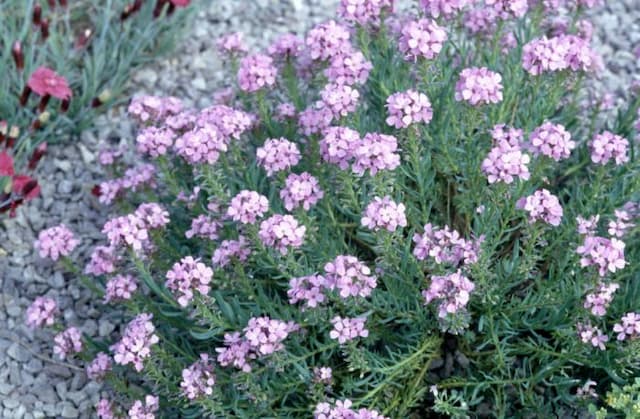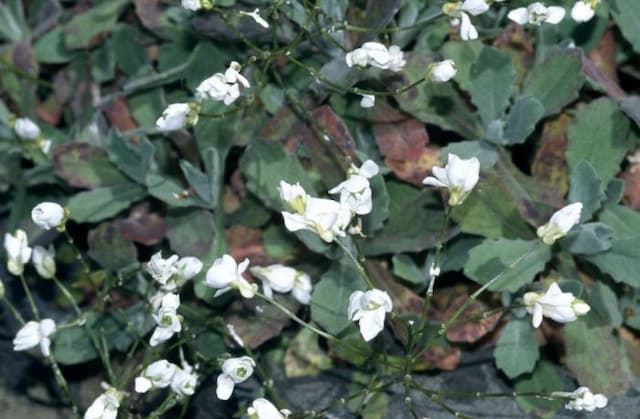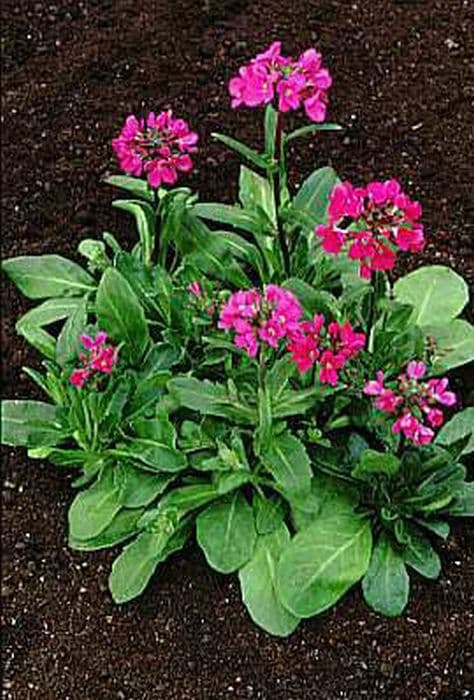Sweet Alyssum Lobularia maritima 'Wonderland White'

ABOUT
Lobularia maritima 'Wonderland White' is renowned for its stunning clusters of small, delicate white flowers that exude a sweet, honey-like fragrance. These blossoms form a dense, carpet-like mat and are known to be long-lasting, providing a continuous display of color. The foliage beneath is a bright green and consists of narrow, lance-shaped leaves that form a compact cushion, complementing the white flowers above. CrossAxisAlignment.end
About this plant
 Names
NamesFamily
Brassicaceae
Synonyms
Sweet Alyssum, Sweet Alison, Seaside Lobularia, Marine Lobularia, Carpet Of Snow
Common names
Alyssum maritimum, Koniga maritima.
 Toxicity
ToxicityTo humans
Sweet Alyssum is not known to be toxic to humans. There are no well-documented cases of Sweet Alyssum poisoning in humans, which means it is generally considered to be a safe plant around adults, children, and when it comes to normal handling or accidental ingestion of small quantities. However, as with any plant, consumption in large quantities or by particularly sensitive individuals could potentially cause a reaction, so it is always advisable to discourage children from eating any plants not designated as food.
To pets
Sweet Alyssum is generally regarded as non-toxic to pets. The plant does not contain any known toxins that would pose a risk to dogs, cats, or other animals commonly kept as pets. Therefore, if pets ingest small amounts of Sweet Alyssum, it is unlikely to cause any significant symptoms of poisoning or any severe health consequences. However, ingesting large amounts might cause mild gastrointestinal upset, which is common with the ingestion of non-food plants by pets. Owners should still prevent pets from eating ornamental plants as a precaution.
 Characteristics
CharacteristicsLife cycle
Annuals
Foliage type
Evergreen
Color of leaves
Green
Flower color
White
Height
6-12 inches (15-30 cm)
Spread
6-12 inches (15-30 cm)
Plant type
Herb
Hardiness zones
5-9
Native area
Mediterranean
Benefits
 General Benefits
General Benefits- Attracts Pollinators: Sweet Alyssum is known for attracting bees, butterflies, and other beneficial insects which helps in the pollination of nearby plants.
- Low Maintenance: Sweet Alyssum is an easy-to-care-for plant that requires minimal upkeep, making it ideal for novice gardeners or those with limited gardening time.
- Aesthetic Appeal: With its delicate white blooms, Sweet Alyssum adds a touch of elegance and simplicity to gardens, borders, and containers.
- Growth Habit: It has a compact, ground-hugging growth habit that makes it an excellent choice for ground cover, rock gardens, or as an edging plant.
- Drought Tolerance: Once established, Sweet Alyssum can tolerate periods of dryness, making it suitable for xeriscaping or drought-prone regions.
- Soil Adaptability: This plant is adaptable to a range of soil types, although it prefers well-drained soils, it can thrive even in less than ideal conditions.
- Seasonal Interest: Sweet Alyssum blooms for an extended period from spring to fall, providing continuous color and interest in the garden.
- Fragrance: The flowers emit a sweet, honey-like fragrance that can be a delightful addition to any outdoor space.
- Versatility: Sweet Alyssum can be used in a variety of garden settings, from hanging baskets and container plantings to mass landscape plantings.
- Rapid Growth: It grows quickly, filling in spaces and providing near-instant gratification for gardeners looking to establish a mature garden look rapidly.
 Medical Properties
Medical PropertiesThis plant is not used for medical purposes.
 Air-purifying Qualities
Air-purifying QualitiesThis plant is not specifically known for air purifying qualities.
 Other Uses
Other Uses- Alyssum can be used as a natural pathway edging, providing a continuous bloom along walkways and defining the borders of garden paths.
- Due to its dense mat-like growth, alyssum can be utilized as a living mulch to suppress weeds and retain soil moisture.
- In photography and painting, alyssum's delicate white flowers can serve as a serene subject or a contrasting element in still life compositions.
- Alyssum may be used in sensory gardens due to its honey fragrance, offering olfactory stimulation and attracting pollinators.
- As a companion plant in vegetable gardens, alyssum can draw beneficial insects that help control pest populations.
- In culinary presentations, alyssum flowers can be used as an edible garnish for salads, desserts, and specialty drinks.
- Gardeners might employ alyssum in pet-friendly landscaping as it's non-toxic and safe for dogs and cats to wander through.
- Alyssum can serve as a natural dye source; the flowers yield subtle hues that can color fabrics or artisanal crafts.
- Fallen alyssum blossoms can be collected and incorporated into potpourri mixes for a sweet, lasting scent.
- Alyssum is suitable for fairy gardens or miniature landscapes, adding a touch of whimsy and scale-appropriate ground cover.
Interesting Facts
 Feng Shui
Feng ShuiSweet Alyssum is not used in Feng Shui practice.
 Zodiac Sign Compitability
Zodiac Sign CompitabilitySweet Alyssum is not used in astrology practice.
 Plant Symbolism
Plant Symbolism- Innocence: The pure white color of the Sweet Alyssum's 'Wonderland White' blooms are often associated with innocence and purity.
- Beauty: The delicate clusters of flowers can symbolize an understated beauty that does not ask for attention but is appreciated by those who notice it.
- Protection: Historically, Sweet Alyssum was believed to offer protection from negative energies and was planted near homes for this purpose.
 Water
WaterSweet Alyssum requires consistent moisture, particularly during hot, dry periods. Watering should occur when the top inch of soil feels dry to the touch, which may be approximately every other day during peak summer heat, depending on climate and soil conditions. Aim to provide the plant with one inch of water per week; this equates to about 0.6 gallons for a square foot of soil. It is best to water Sweet Alyssum in the early morning to allow foliage to dry out over the course of the day, which can help prevent disease. Avoid overwatering, as this can lead to root rot; ensure good drainage in the soil to facilitate this.
 Light
LightSweet Alyssum thrives in full sunlight to partial shade. The best spot for Sweet Alyssum is a location where it can receive at least six hours of direct sunlight daily. While it can tolerate some light shade, especially in hotter climates, too much shade can result in fewer flowers and a leggier plant.
 Temperature
TemperatureSweet Alyssum grows best in temperatures between 60°F and 75°F but can survive in temperatures as low as 40°F and as high as around 85°F. It is a cool-season annual, often performing better in spring and fall and may struggle during the hot summers, especially in regions with temperatures consistently above 85°F.
 Pruning
PruningPruning Sweet Alyssum encourages bushier growth and more prolific blooming. Trim the plant back by one-third to one-half when it begins to look leggy or after a major flush of blooms, typically in late spring or early summer. Pruning can occur every few weeks during the growing season to maintain shape and encourage new blooms.
 Cleaning
CleaningAs needed
 Soil
SoilSweet Alyssum 'Wonderland White' thrives in well-draining soil enriched with organic matter. The ideal pH range for this plant is slightly acidic to neutral, around 6.0 to 7.0. A good soil mix for Sweet Alyssum includes two parts peat moss or coco coir, one part perlite or sand, and one part compost or well-rotted manure.
 Repotting
RepottingSweet Alyssum 'Wonderland White' typically does not require frequent repotting as it is often grown as an annual. If grown as a perennial in suitable climates, repotting every 2 to 3 years or when the plant appears to be root-bound can promote healthier growth.
 Humidity & Misting
Humidity & MistingSweet Alyssum 'Wonderland White' is tolerant of a range of humidity conditions and does well in average environmental humidity. Excessive humidity is not required; just ensure that it is not under extremely dry conditions.
 Suitable locations
Suitable locationsIndoor
Place in bright, indirect light and ensure good airflow for indoor Sweet Alyssum.
Outdoor
Plant in partial shade to full sun in fertile, well-drained soil for outdoor Sweet Alyssum.
Hardiness zone
9-11 USDA
 Life cycle
Life cycleLobularia maritima 'Wonderland White', more commonly known as Sweet Alyssum 'Wonderland White', begins its life cycle as a seed, requiring light for optimal germination. Once sown, the seeds typically germinate within 7-14 days under suitable warm conditions. The germinated seedlings develop into compact, bushy foliage with a profusion of tiny white flowers, progressing through a vigorous vegetative stage. Following vegetative growth, the plant enters the flowering stage, blooming profusely throughout spring, summer, and into fall, attracting pollinators such as bees and butterflies. After pollination, the flowers develop into seed pods, completing the reproductive phase. As a short-lived perennial or annual depending on the climate, Sweet Alyssum 'Wonderland White' eventually senesces, with seeds dispersing to give rise to new plants, thus continuing the cycle.
 Propogation
PropogationPropogation time
Spring-Summer
Propogation: Lobularia maritima 'Wonderland White', commonly known as Sweet Alyssum, is primarily propagated through seeds. The best time to sow Sweet Alyssum seeds is in the spring after the last frost when the soil has warmed up, or in autumn where winters are mild. To propagate by seed, simply scatter the seeds over prepared soil where you want the plants to grow. Cover them lightly with soil, no more than 1/8 inch deep, and mist to keep the soil moist until germination, which typically occurs within 7 to 14 days. Thinning the seedlings ensures that the remaining plants have enough space to develop properly. Sweet Alyssum's rapid and reliable germination makes seed propagation the most popular method for this fragrant, ground-covering plant.






![Aubrieta [Axcent Burgundy]](/_next/image?url=https%3A%2F%2Fplants-admin.emdemapps.com%2Fimages%2Fplants%2F%2Fimages%2F604b5b7b548d8.png&w=640&q=75)


